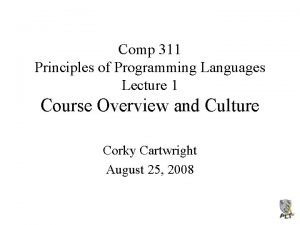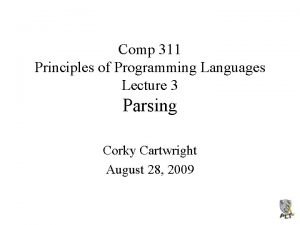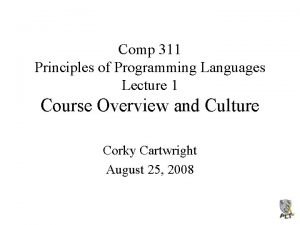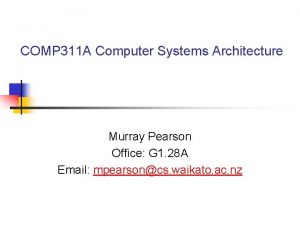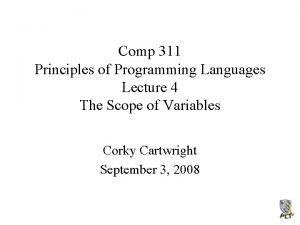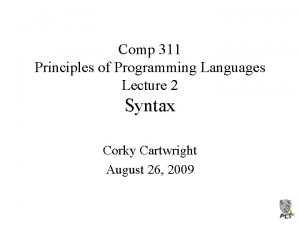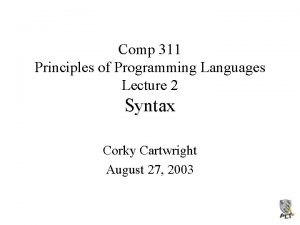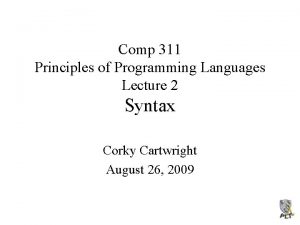Comp 311 Principles of Programming Languages Lecture 2








- Slides: 8

Comp 311 Principles of Programming Languages Lecture 2 Syntax Corky Cartwright August 27, 2003

Syntax: The Boring Part of Programming Languages • Programs are represented by sequences of symbols. • These symbols are represented as sequences of characters that can be typed on a keyboard (ASCII). • What about Unicode? • To analyze or execute the programs written in a language, we must translate the ASCII representation for a program to a higher-level tree representation. This process, called parsing, conveniently breaks into two parts: – lexical analysis, and – context-free parsing (often simply called parsing).

Lexical Analysis • Consider this sequence of characters: begin middle end • What are the smallest meaningful pieces of syntax in this phrase? • The process of converting a character stream into a corresponding sequence of meaningful symbols (called tokens or lexemes) is called tokenizing, lexing or lexical analysis. A program that performs this process is called a tokenizer or a lexer. • In Scheme, we tokenize (set! x (+ x 1)) as ( set! • x ( + x 1 ) ) Similarly, in Java, we tokenize System. out. println("Hello World!"); as System. out. println ( "Hello World!" ) ;

Lexical Analysis, cont. • Tokenizing is straightforward for most languages because it can be performed by a finite automaton (Fortran is an exception!). – The rules governing this process are (a very boring) part of the language definition. • Parsing a stream of tokens into structural description of a program (typically a tree) is harder.

Parsing • Consider the Java statement: x = x + 1; where x is an int variable. • The grammar for Java stipulates (among other things): – The assignment operator may be preceded by an identifier and must be followed by an expression. – An expression may be two expressions separated by a binary operator, such as +. – An assignment expression can serve as a statement if it is followed by the terminator symbol. Hence, we can deduce from the grammatical rules of Java that the above sequence of characters (tokens) is a legal program statement.

Parsing Token Streams into Trees • Consider the following ways to express an assignment operation: x=x+1 x : = x + 1 (set! x (+ x 1)) • Which of these do you prefer? • It should not matter much. • To eliminate the irrelevant syntactic details, we can create a data representation that formulates program syntax as trees. For instance, the abstract syntax for the assignment code given above could be (make-assignment <Rep of x> <Rep of x + 1>) • or new Assignment(<Rep of x> , <Rep of x + 1>)

A Simple Example Exp : : = Num | Var | (Exp Exp) | (lambda Var Exp) Num is the set of numeric constants (given in the lexer spec) Var is the set of variable names (given in the lexer spec) • To represent this syntax as trees (abstract syntax) in Scheme ; exp : = (make-num number) + (make-var symbol) + (make-app exp) + ; (make-proc symbol exp) (define-struct (num n)) (define-struct (var s)) (define-struct (app rator rand)) (define-struct (proc param body)) ; ; param is a symbol not a var! • app represents a function application • proc represents a function definition

Top Down (Predictive) Parsing Idea: design the grammar so that we can always tell what rule to use next starting from the root of the parse tree by looking ahead some small number of token (LL(k) parsing). Can easily be implemented by hand: called recursive descent. Conceptual aid: syntax diagrams to express context free grammars.
